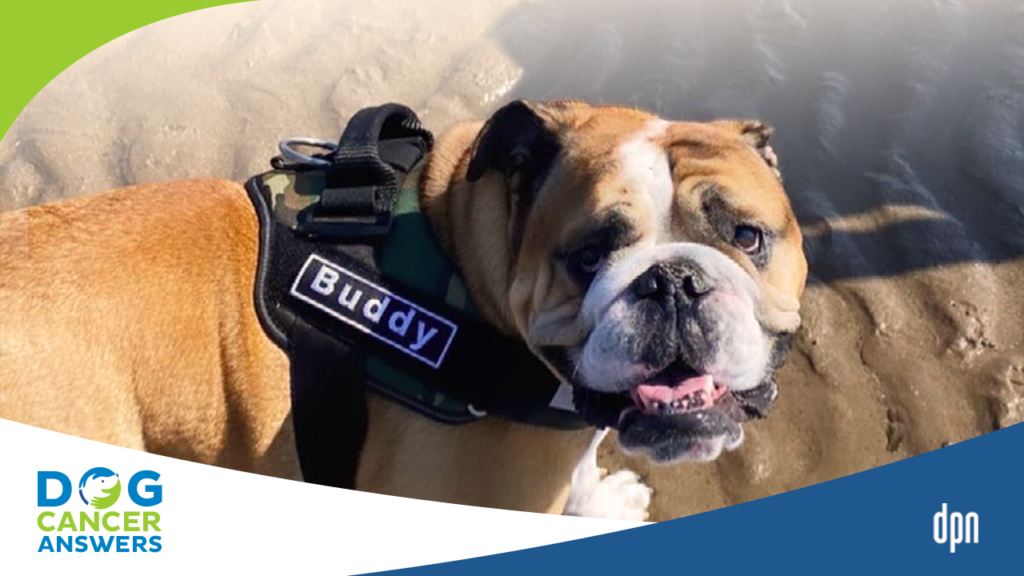EPISODE 191 | RELEASED November 7, 2022
Will Cutaneous Hemangiosarcoma Come Back? | Dr. Brooke Britton
Do you know which dog skin cancer can be caused by the sun? Oncologist Brooke Britton explains cutaneous hemangiosarcoma.
SHOW NOTES
Many dog lovers have experienced the insidious cancer hemangiosarcoma, which develops in the blood vessels. But caller Lou has a question about cutaneous hemangiosarcoma, a less-common form that develops on the skin instead of in organs like the spleen or heart.
But Dr. Brooke Britton has good news – the best thing about cutaneous hemangiosarcoma is that these tumors can often be stopped in their tracks with surgery alone. Learn which dogs are at risk for skin cancer, how to recognize these tumors, treatment options, and how likely it is to come back or spread.
[00:00:00] >> Dr. Brooke Britton: Some of these tumors are solar induced and some of them are not. The ones that are solar induced tend to be in dogs that are more lightly pigmented, that have thin hair coats.
[00:00:12] >> Announcer: Welcome to Dog Cancer Answers, where we help you help your dog with cancer.
[00:00:18] >> Molly Jacobson: Thank you for joining us today, listeners. We’re taking a call today from Lou. His dog has hemangiosarcoma, and it’s cutaneous, or dermal, or skin hemangiosarcoma. And he’s looking for some guidance. So Dr. Brooke Britton, veterinary oncologist, is joining us to help Lou out and provide some guidance and insight.
Dr. Britton, thanks so much for joining us again.
[00:00:46] >> Dr. Brooke Britton: Thank you for having me again.
[00:00:48] >> Molly Jacobson: Let’s take a listen to Lou’s question.
[00:00:51] >> Lou: My question is, my dog has been diagnosed with cutaneous dermal or dermal cutaneous hemangiosarcoma. Uh, I’ve been told to keep him out of the sun. Chemo was not recommended. Uh, we had the, uh, spot taken out through a, uh, biopsy, and the cancer was not multiplying fast and it was cutaneous only. So my question is, what are the possibility of it coming back?
Thank you.
[00:01:21] >> Molly Jacobson: Dr. Britton, what would you say to Lou about his dog’s cancer?
[00:01:27] >> Dr. Brooke Britton: So hemangiosarcoma, in most cases, is a pretty aggressive cancer, but when it occurs in the top layers of the skin, and it’s confined to the top layers of the skin, it actually can do very well with surgical removal alone. And so there are a lot of things that we don’t know about this dog, including the breed of the dog, how big the lesion was, where it was located, and also whether it was confined on the biopsy to the top layer of the skin, or if there was any invasion into the subcutaneous or muscle layers.
It sounds like it was more superficial from his description, but there is a lot that we don’t know. And what I would say is we also don’t know the margin on the biopsy. So, was the tumor completely removed? If the tumor was very small, you know, maybe a few millimeters or so, and it was completely removed, and there was a margin of normal tissue as a buffer between the tumor and the edge of the sample, the piece of tissue that was taken out, then it’s possible that this tumor could not come back.
If the tumor was incompletely removed or it was larger or more invasive, I would have more concerns about possible recurrence down the line. And as a rule, many dermal hemangiosarcoma dogs are predisposed to having multiple tumors. So even if the tumor doesn’t grow back in the site that it was removed, this may be a breed or a dog that’s more predisposed to developing future tumors over the skin.
He did mention something about his dog being reminded to stay out of the sun. So some of these tumors are solar induced and some of them are not. The ones that are solar induced tend to be in dogs that are more lightly pigmented, that have thin hair coats. And so those breeds tend to be predisposed to the solar induced hemangiosarcomas. And some dogs just develop dermal or cutaneous hemangiosarcoma because, we often don’t know all the reasons why.
The other thing that is important to understand is that these tumors can metastasize or spread. And so depending upon where they’re located and their size, surgery sometimes is important to remove the primary tumor, but we may want to, depending upon different factors that play in this dog, look for evidence of tumor spread or maybe monitor for tumor spread in future.
[00:04:02] >> Molly Jacobson: So it sounds to me like Lou should be making sure that he’s very vigilant about any future spots that come up, making sure that those get attended to really quickly, and checking in with his veterinarian to be sure that it hasn’t metastasized and that it was a less invasive tumor, or that they got good margins as they, as they took it out.
[00:04:24] >> Dr. Brooke Britton: Yes.
[00:04:24] >> Molly Jacobson: To just to get those questions answered. What are the breeds that are more likely to develop skin hemangiosarcoma?
[00:04:33] >> Dr. Brooke Britton: Again, usually they’re lightly pigmented, thinly hair coated dogs.
[00:04:37] >> Molly Jacobson: Okay.
[00:04:37] >> Dr. Brooke Britton: And I’ve actually had a fair number of pit bulls as well that have developed hemangiosarcoma of the dermis or subcutis. We also see these tumors in dogs that are kind of exposed to the sun regularly, dogs that are outdoors regularly, the, for the solar induced tumors. Or dogs from tropical or desert areas, for example, that are maybe free roaming or kept outdoors much of the time.
[00:05:04] >> Molly Jacobson: Is there anything else that Lou should keep in mind as – let’s assume that it’s the best case scenario and they got good margins and they’re pretty confident that it’s not going to recur or that the likelihood is low. Are there things he should be doing from now on, other than keeping the dog covered up in the sun, that you would recommend to further shore up that prevention of future recurrence?
[00:05:29] >> Dr. Brooke Britton: Unfortunately, there’s really nothing else that can prevent these tumors from forming. So sun avoidance is certainly a good thing to start with, but there’s really nothing else that we can do reliably to prevent them. Some dogs are just genetically predisposed.
So, to your earlier point, getting early checkout of lumps and bumps, or even if something looks like a blood blister or a skin tag, or looks fairly benign or quiet or small and isn’t bleeding, these tumors can sometimes change quickly or they may be dermal hemangiosarcomas and, and look fairly benign.
So, in a dog with this history, any new lump or bump, especially if there’s a reddish, brownish, blackish, crusting lump or bump, I would recommend having that checked out. Or at least monitored, and if there’s growth or any change, then maybe have a biopsy taken of future lesions like that.
[00:06:26] >> Molly Jacobson: Okay. Let’s take a break here and then when we come back, I wanna ask you about Yunnan baiyao.
And we are back with veterinary oncologist, Dr. Brooke Britton.
I know a lot of people whose dogs have hemangiosarcoma use Yunnan baiyao, which is that Chinese herbal remedy that seems to help reduce bleeding, increase clotting. Is that something that might be useful for him to use with his dog with cutaneous hemangiosarcoma?
[00:06:55] >> Dr. Brooke Britton: It depends. If there are no lesions on the body, then it’s unlikely to help prevent or, you know, treat any microscopic disease. We don’t know definitively that Yunnan baiyao delays or prevents these tumors from recurring. It is also, as with many supplements, an unregulated supplement, it’s available in many different formulations and most of the times we don’t know exactly what’s in Yunnan baiyao.
I would say that most formulations that we tend to recommend are fairly well tolerated, anecdotally, and there has been some published literature looking at Yunnan baiyao with hemangiosarcoma, either in vitro or in vivo. The most useful way that we can employ it is probably for the theoretical effect that it has on delaying or preventing bleeding.
And in some dogs anecdotally, we feel that maybe it has some efficacy in that regard, in other dogs we don’t know that it really works at all. But in general, it’s a pretty benign supplement in most dogs to use, and if there were actively bleeding lesions on the body, then I would say that that would be something that we could add in to see if it had any effect and it’s unlikely to harm the dog. But if there are no active lesions on the body, it’s probably not going to delay or prevent recurrence or move the dial much in that regard.
[00:08:21] >> Molly Jacobson: Right. So it sounds like Lou had this tumor removed and hopefully with good margins and that’s the main treatment option for cutaneous hemangiosarcoma. Are there any other steps that Lou’s oncologist might wanna take if there’s a recurrence and it’s more aggressive?
[00:08:41] >> Dr. Brooke Britton: Yeah. So with purely dermal hemangiosarcoma, usually surgical removal is the treatment of choice, and oftentimes the only thing that we need to do, because the metastatic rate is considered to be pretty low-
[00:08:53] >> Molly Jacobson: Okay.
[00:08:53] >> Dr. Brooke Britton: -if it’s solely confined to the top layer of the skin. If we have subcutaneous invasion or invasion into the underlying muscle, those tend to have a much higher metastatic rate over time, and I would recommend chemotherapy in those dogs. It’s usually a Doxorubicin based protocol, so a dog would go in for injections usually every three weeks for up to around five treatments of that drug.
Sometimes we can employ low dose oral or metronomic chemotherapy protocols, either in conjunction with injectable or as a maintenance protocol after injectable is finished or in place of injectable. So there are other treatments for more aggressive or invasive tumors, but again, those that are confined purely to the skin that have a low growth rate and we have a complete excision, usually proactive monitoring is all that we need to do – as long as we know that there’s no evidence of the metastasis at the time of diagnosis.
[00:09:52] >> Molly Jacobson: Where are you looking for metastasis if it does occur?
[00:09:55] >> Dr. Brooke Britton: Most hemangiosarcomas will metastasize at some point – again, with the exception of the purely dermal ones – to the lungs or the spleen or the liver, other abdominal organs. There’s also a chance of metastasis to the brain. It is rare for us to see that, but yet it is one of the more common metastatic sarcomas to the brain.
So there are many different places that we can see the metastasis. Some people will use the term metastasis for other skin lesions that pop up, or say satellite metastasis. But usually when we think of metastasis, we’re thinking about more distant sites like internal into the chest or the abdomen.
[00:10:35] >> Molly Jacobson: When someone has an internal organ that has hemangiosarcoma, a spleen or liver tumor for example, do you think that ever is a metastasis from skin tumors that perhaps weren’t found earlier or weren’t discovered in time?
[00:10:51] >> Dr. Brooke Britton: That can happen. Usually there’s gonna be some pretty obvious temporal association between a lesion that is on the skin, or maybe a recent history of having a lesion that’s been bleeding that was assumed to be something else maybe, and was taken off-
[00:11:06] >> Molly Jacobson: Okay.
[00:11:07] >> Dr. Brooke Britton: -in weeks or months past-
[00:11:09] >> Molly Jacobson: Okay.
[00:11:09] >> Dr. Brooke Britton: -and then we see metastasis. So occasionally I’ve seen that, but most of the times we see metastasis, it’s, it’s not common for the skin form to find it at diagnosis, but most of the time, so we’re gonna see those things concurrently, as opposed to, you know, a skin lesion that was removed two years ago and then there’s hemangiosarcoma somewhere else. But-
[00:11:29] >> Molly Jacobson: Okay.
[00:11:30] >> Dr. Brooke Britton: We do think that some of these dogs just have a genetic predisposition to hemangiosarcoma in general. If they have skin hemangio, it doesn’t necessarily mean that they’re going to develop organ or internal hemangiosarcoma, but there are some dogs that have a history of skin hemangio, and then maybe a long time down the line, even if they have no cutaneous lesions, they may have organ hemangiosarcoma.
So in those dogs, maybe, rather than being a late metastasis, although that’s possible, maybe those dogs are just genetically predisposed to hemangio as a disease complex, so to speak.
[00:12:03] >> Molly Jacobson: Okay, so the person who’s listening and their dog has internal hemangiosarcoma, and they’re thinking, Oh no, you know, that thing we thought was a bug bite five years ago, maybe it was actually skin hemangiosarcoma, they don’t have to beat themselves up. It’s not likely that-
[00:12:21] >> Dr. Brooke Britton: Correct.
[00:12:21] >> Molly Jacobson: Okay, good.
[00:12:22] >> Dr. Brooke Britton: That’s very, very unlikely.
[00:12:24] >> Molly Jacobson: Okay.
[00:12:24] >> Dr. Brooke Britton: Most of the times when we find hemangiosarcoma internally, that’s the, what’s called the primary site or where the tumor originated rather than a metastatic lesion.
[00:12:34] >> Molly Jacobson: Wonderful. Okay, great. Is there anything else that you feel is important for Lou to know about his dog’s cutaneous hemangiosarcoma?
[00:12:44] >> Dr. Brooke Britton: It sounds like he’s very proactive with monitoring his dog and he had the problem addressed very quickly and efficiently. So I think monitoring for his dog, as long as the biopsy indicated a complete removal, it sounds like the veterinarian who did the procedure was not as concerned based on what he’s describing in terms of follow up or the potential for this to behave aggressively in the future. But I would just recommend at least keeping up with his annual exams with his dog.
And also if any new lump or bump arises, particularly if there’s a lesion that looks similar to the one that was proven to be hemangiosarcoma, then he brings that to his vet’s attention as soon as he notices it. Because like many things in our oncologic world, the sooner things are caught, so to speak, the sooner that they are investigated, usually there are more options for us and maybe a better chance at long-term positive outcome or maybe even cure of a tumor.
[00:13:45] >> Molly Jacobson: Thank you, Dr. Britton. I appreciate your help with this question.
[00:13:49] >> Dr. Brooke Britton: Absolutely.
[00:13:52] >> Molly Jacobson: And thank you listener, for listening, and Lou, you, for calling in with your question. Cutaneous hemangiosarcoma is not a cancer we think about every day, but it’s a good one to keep in mind for people with light colored dogs with thin hair coats. If you have a question like Lou did, reach out on our Listener Line at (808) 868-3200. You can leave a message with a question and that will be answered on a future episode of Dog Cancer Answers. As always, check the show notes for links related to today’s show.
And I’m Molly Jacobson. From all of us here at Dog Podcast Network, I would like to wish you and your dog a very warm, Aloha.
[00:14:36] >> Announcer: Thank you for listening to Dog Cancer Answers. If you’d like to connect, please visit our website at dogcanceranswers.com, or call our Listener Line at (808) 868-3200. And here’s a friendly reminder that you probably already know: this podcast is provided for informational and educational purposes only. It’s not meant to take the place of the advice you receive from your dog’s veterinarian.
Only veterinarians who examine your dog can give you veterinary advice or diagnose your dog’s medical condition. Your reliance on the information you hear on this podcast is solely at your own risk. If your dog has a specific health problem, contact your veterinarian. Also, please keep in mind that veterinary information can change rapidly, therefore, some information may be out of date.
Dog Cancer Answers is a presentation of Maui Media in association with Dog Podcast Network.
Hosted By
SUBSCRIBE ON YOUR FAVORITE PLATFORM
Topics
Editor's Picks
CATEGORY










